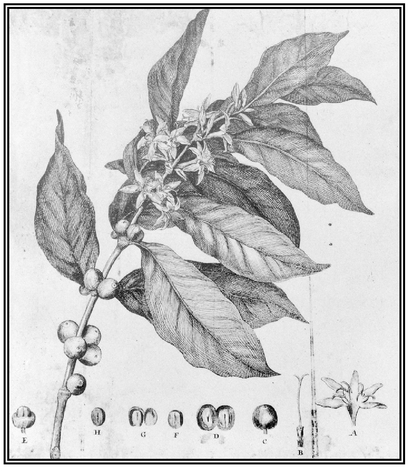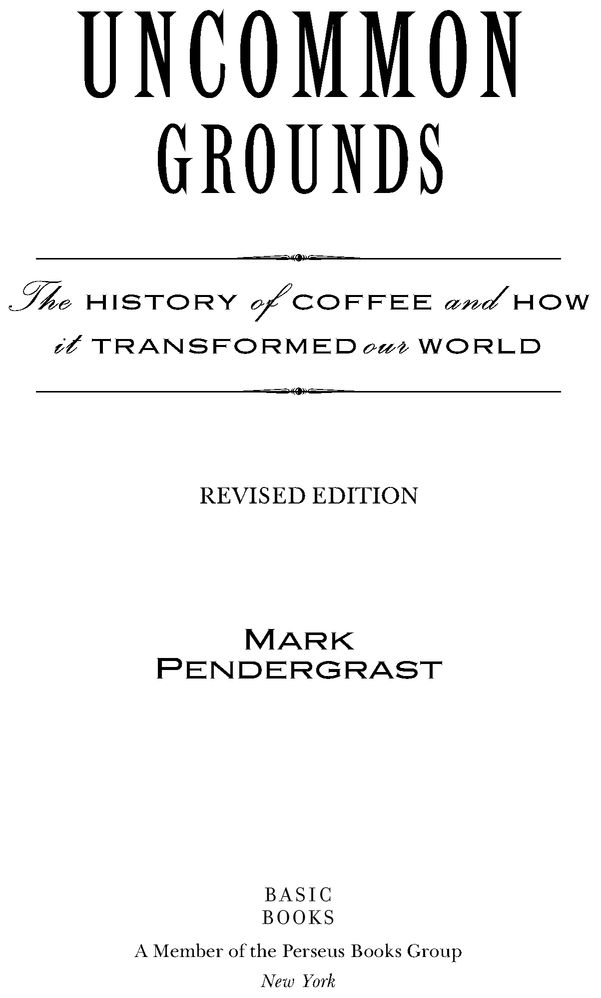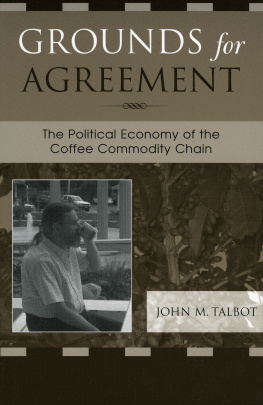Table of Contents
This detailed engraving was one of the first accurate portrayals of the exotic coffee plant, published in 1716 in Voyage de lArabie Heureuse
To the memories of Alfred Peet (1920-2007), coffee curmudgeon supreme, and Ernesto Illy (1925-2008), espresso master
The voodoo priest and all his powders were as nothing compared to espresso, cappuccino, and mocha, which are stronger than all the religions of the world combined, and perhaps stronger than the human soul itself.
Mark Helprin, Memoir from Antproof Case (1995)
The smell of roasting coffee hit me like a waft of spice.... It was a smell halfway between mouth-watering and eye-watering, a smell as dark as burning pitch; a bitter, black, beguiling perfume that caught at the back of the throat, filling the nostrils and the brain. A man could become addicted to that smell, as quick as any opium.
Anthony Capella, The Various Flavors of Coffee (2008)
PROLOGUE
The Oriflama Harvest
San Marcos region, Guatemala. Picking coffee berries (known as cherries) for the first time, I struggle to keep my balance on the precipitous hillside. My basket, or canasta, is tied around my waist. As Herman, my caporal (supervisor), requested, I try to pick only the rich red cherries, but sometimes I accidentally knock loose a green one. Ill have to sort them later.
I pop the skin of a ripe coffee cherry open in my mouth and savor the sweet mucilage. It takes a bit of tongue work to get down to the tough-skinned parchment protecting each bean. Like peanuts, coffee beans usually grow in facing pairs. Spitting out the parchment, I finally get the two beans, which are covered by a diaphanous silver skin. In some cases where the soil lacks sufficient boron, I might have found only one bean, called a peaberry, considered by some to possess a slightly more concentrated taste. I spit out the seeds, too hard to chew.
I hear other harvesterswhole families of themchatting and singing in Spanish. This is a happy time, when the years hard work of pruning, fertilizing, weeding, tending, and repairing roads and water channels comes down to ripe coffee. I sing a song with a few Spanish phrases: mi amor, mi corazn.
When I stop, I hear giggles and applause. Unwittingly, I have attracted a group of kids, who now wander off to resume picking or pestering their parents. Children begin helping with the harvest when they are seven or eight. Though many campesinos keep their children out of school at other times for other reasons, its no coincidence that school vacation in Guatemala coincides with the coffee harvest.
I am 4,500 feet above sea level on Oriflama, the coffee finca (plantation) owned by Betty Hannstein Adams. Bettys grandfather, Bernhard Hannstein (Don Bernardo), arrived in Guatemala over a hundred years ago, one of many German immigrants who pioneered the countrys coffee production. Oriflama, which contains over four hundred acres, is half of the original farm, which was called La Paz.
Most of the coffee trees are caturra and catuai, hybrids that are easier to harvest because they are shorter and more compact than the older bourbon variety. Still, I have to bend some branches down to get at them. After half an hour I have picked half a canasta, about twelve pounds of cherries that, after processing to remove the pulp, mucilage, and parchment, will produce two pounds of green coffee beans. When roasted, they will lose as much as 20 percent more in weight. Still, I have picked enough to make several pots of fine coffee. Im feeling pretty proud until Herman, who stands just over five feet and weighs a little over one hundred pounds, shows up with a full canasta and gently chides me for being so slow.
The farm is beautiful, covered with the green, glossy-leafed coffee trees, prehistoric tree ferns and Spanish daggers along the roadside (to prevent erosion), rolling hills, invisible harvesters calling, children laughing, birds chirruping, big shade trees dappling hillsides, springs and streams. As in other high-altitude coffee-growing areas, the temperature never strays far from 75F.
In the distance I can see the volcano, Santa Mara, and the smoke from the smaller cone, Santiago, where in 1902 a side eruption exploded, burying Oriflama under a foot of ash and killing all the songbirds. Oh God, what a sight, wrote Bettys grandmother, Ida Hannstein, soon after. As far as the eye could see everything was blue and gray and dead, like a mammoth cemetery.
It is difficult to imagine that scene now. The nitrogen-fixing shade treesinga, poro, and othersalong with the groves of cypresses and oaks and the macadamia trees grown to diversify output, provide a much-needed habitat for migratory birds. At breakfast I had melon, cream, and honey that came from the plantation; also black beans, rice, and of course, coffee.
By 4:00 P.M. the harvest day is over, and everyone brings bulging bags of coffee cherries to the beneficio (processing plant) to be weighed. In other parts of Guatemala, the Mayan Indians are the primary harvesters, but here they are local ladinos, whose blood combines an Indian and Spanish heritage. They are all very small, probably owing to their ancestors chronic malnutrition. Many wear secondhand American T-shirts that appear incongruous here, one from the Kennedy Space Center.
Tiny women carry amazingly large bags, twice their eighty-pound weight. Some of the women carry babies in slings around front. A good adult picker can harvest over two hundred pounds of cherries and earn $8 a day, more than twice the Guatemalan minimum daily wage.
In Guatemala, the contrast between poverty and wealth is stark. Land distribution is lopsided, and those who perform the most difficult labor do not reap the profits. Yet there is no quick fix to the inequities built into the economic system, nor any viable alternatives to coffee as a crop on these mountainsides. The workers are in many ways more content and fulfilled than their counterparts in the United States. They have a strong sense of tradition and family life.
As the workers bring in the harvest, I ponder the irony that, once processed, these beans will travel thousands of miles to give pleasure to people who enjoy a lifestyle beyond the imagination of these Guatemalan laborers. Yet it would be unfair to label one group villains and another victims in this drama. I realize that nothing about this story is going to be simple.
I donate my meager harvest to a kid and turn once again to look at the valley and volcano in the distance. Back in the United States, I have already begun to accumulate mounds of research material that threaten to swamp my small home office, where I will write this history of coffee. But now I am living it, and I can tell that this experience, this book, will challenge my preconceptions and, I hope, those of my readers.
INTRODUCTION
Puddle Water or Panacea?
O Coffee! Thou dost dispel all care, thou are the object of desire to the scholar. This is the beverage of the friends of God.









